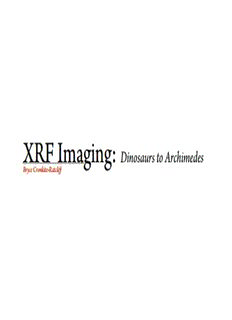
XRF Imaging: Dinosaurs to Archimedes PDF
Preview XRF Imaging: Dinosaurs to Archimedes
XRF Imaging: Dinosaurs to Archimedes Bryce Cronkite-Ratcliff …XRF? Technique for imaging elemental trace concentration using Synchrotron X-ray Radiation Vast array of applications, including: Archeology Paleontology Medicine Flourescense electron nucleus electron orbit Requirements High-luminosity X-ray source Multi-channel detectors separate channels detect disparate energy “windows” to record different elements Motorized sample platform Rapid-scan technology Basic Setup (top-down) Beamline 6-2 Brightest beamline at SSRL in the relevant energy range Rapid Scanning Absolutely necessary for sizable samples: Scanning time for 14 cm X 17 cm rectangle at 600 dpi ~ 36 hours + readout time + motor direction change time Hassle caused by beam top-off New hardware and software developed: Stores scanned information locally while scanning, dumping into a control computer at the end of each line. Decouples data processing time from scanning timeframe Enables live update of the image Applications: Parkinson’s Cerebral Signature Fe Zn Fe + Zn
Description: